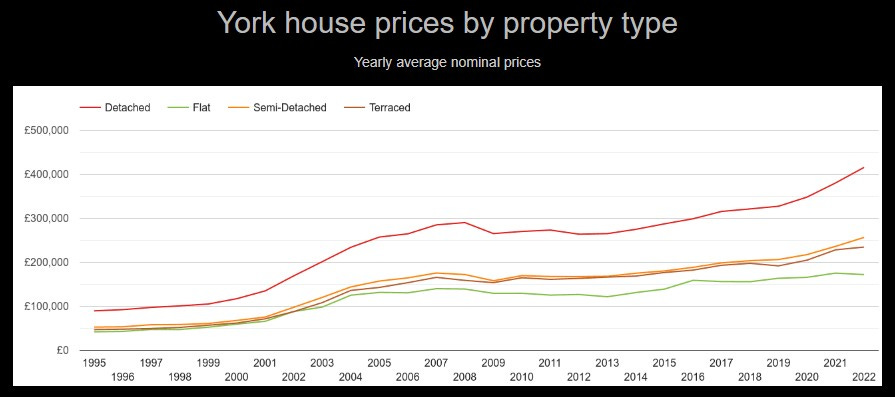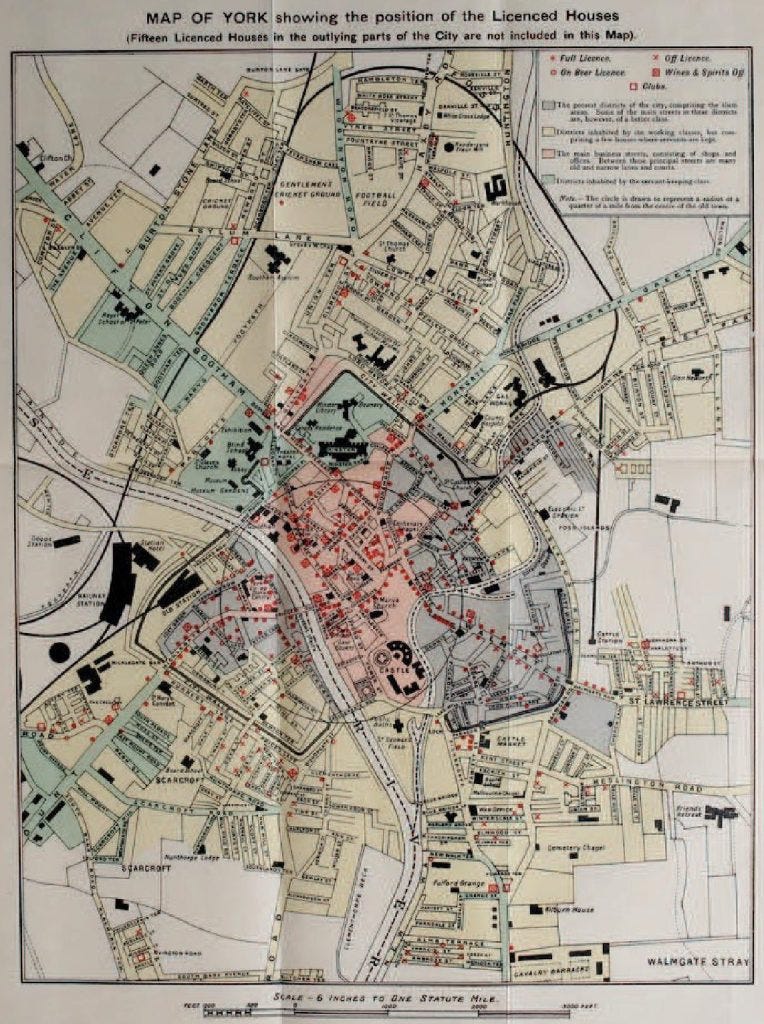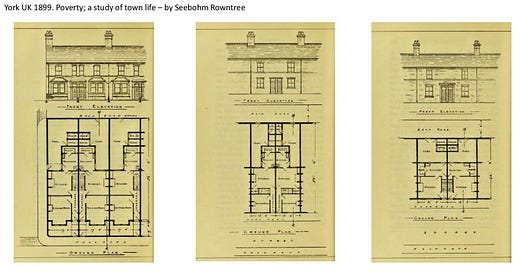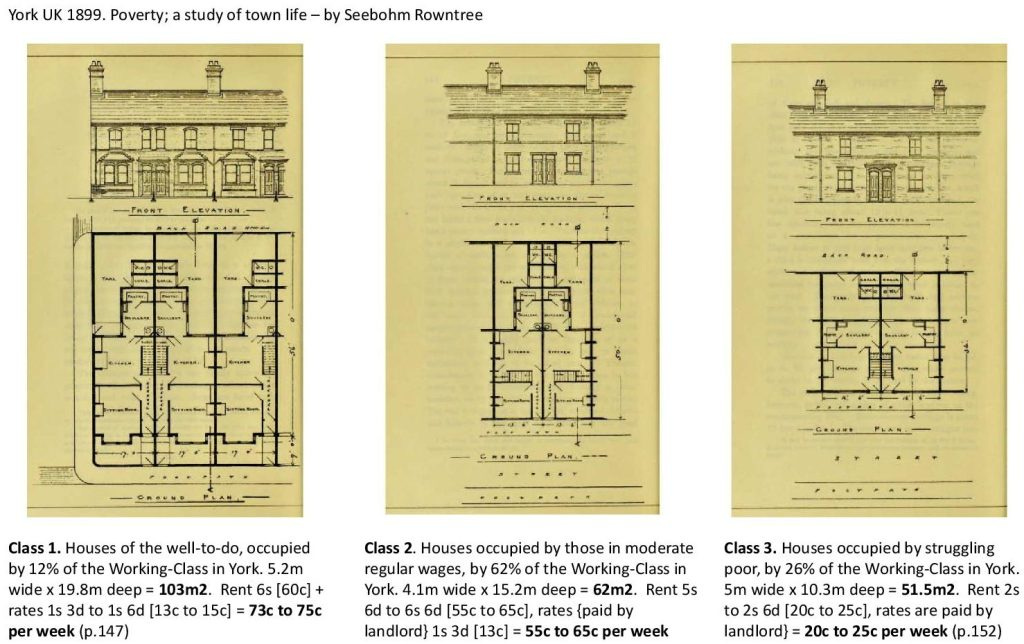1890s - City of York
My notes on Germany 1648 to 1806 , Germany 1800 to 1840s , Waikato the golden age 1840s to 1850s , Waikato 1860s , Gentry & Speculators , The beginning of modern planning: Water, Sewage, Housing, Transport, City Centre, Markets and Zoning, 1890s: Introduction, Dwellings & Lots, Reason for Zoning, Horses, Cyclists & road deaths
This post is based on Seebohm Rowntree’s Poverty: a study of town life, York 1899
The immediate causes of overcrowding, the evidence points clearly to the fact that the great bulk of it is due to sheer inability on the part of the tenants to pay rent enough to secure adequate accommodation (p.178). The root difficulty with the housing of the working classes lies in the high price of land (p.180)
Mr Charles Booth estimated that 30.7 percent of the total population of London were living in poverty. Mr Rowntree’s study estimated 27.84 percent of the population of York were living in poverty (p. 299), [and] it is probable that 25 to 30 percent of the town population of the United Kingdom were living in poverty ... at the time when 77 percent of the population of the United Kingdom was “urban” and only 23 percent “rural” (p. 301). There are two types of poverty – (A) “Primary” poverty - Families whose total earnings are insufficient to obtain the minimum necessaries for the maintenance of mere physical efficiency; and (B) “Secondary” poverty - Families whose total earnings would have been sufficient for the maintenance of physical efficiency were it not that some portion of it was absorbed by other expenditure, either useful or wasteful (p. 296). In York 10 percent of the total population of the city were in “primary” poverty and 17.93 percent were in “secondary” poverty (pp. 297-298). The minimum weekly expenditure to stay out of “primary” poverty was 21s 8d [217c] made up of (1) food* 12s 9d [128c]; rent 4s [40c or 18% of expenditure]; all else 4s 11d [49c] (p.296). *based on Prisoners fed upon the most liberal diet (of 3900 Calories) to maintain their body weight (p.94).
~ Conversion table 1s=10c and 1d=0.8333c from Wikipedia
The city of York in 1899 covered an area of 3,692 acres [14.9km2 or 1,494 hectares], and contained about 15,000 houses, with an estimated population of 75,812. For municipal purpose it was divided into six wards, in which ‘... old dwellings-houses are constantly being pulled down, either because they are condemned, or because the site is wanted for business purposes ... nearly all the inhabitants of York live in separate houses, the few tenement houses which exist are to be found in the central portion of the city’. York in 1899 had a population density of 5,075 people per km2 or 50 people per ha or 20.5 people per acre (Chapter 1). The late Sir Benjamin Richardson specified that no city would be really healthy which contained more than 25 persons to the acre [61pph or 6,188ppkm2] (p.169). As a reference, Hamilton in 1901 had 1,253* people on 1,859acres or 7.5km2 or 750 ha, giving a density of 167ppkm2 or 1.6pph or 0.67ppa. In 1961 Hamilton had 42,212* people on 6,618acres** or 26.78km2 or 2,678ha giving a density of 1,575ppkm2 or 16pph or 6ppa, and in 2018 it had 160.911* on 27,181acres or 110 km2* or 11,000ha giving a density of 1,462ppkm2 or 14.6pph or 5.52ppa.
** Hamilton District Scheme 1960s

Back-to back Houses. – There are 1,398 back-to-back houses in York. This is equal to about 9.3 percent of total houses in the city, and includes houses without through ventilation. Some of these are back-to-back with warehouses, stables, or water-closets; others are built against a blank wall. Quoting Dr Hill “a house in which there is no through ventilation is necessarily close and stuffy, often dark, and always detrimental to health”. Fortunately the by-laws that have been in force in York since 1870 do not allow back-to-back housing to be erected (p.159). In many towns the root difficulty in connection with the housing of the working classes lies in the high price of building land. In York, Land suitable for building and within three miles of the centre of the city can be bought for about £60 [$120] to £80 [$160] per acre (p. 180).

‘The state of York’s SEWAGE – a disposal scheme was completed in 1897 (p. 183). THE WATER SUPPLY - is in the hands of a private company, who levy a water-rate equal to about 5 percent of the rateable value of each house [for Class 2 house 0.65c], with an additional sum varying from 3s to 9s 8d [30c to 97c] according to the rent of the house for each water-closet and 9s 4d [93c] for each bathroom’ (p. 187). MEAT SUPPLY – There are no less than 94 private slaughter-houses in York ... Not a single one of the 94 slaughter-houses is built in accordance with the Local Government Board by-laws (p. 191). UNHEALTHY TRADES- Although there are trades carried on under unhealthy conditions, there are none in York that are either dangerous or unhealthy according to the official acceptation of these terms (p. 192). If the by-laws for back-to-back housing and meat suppliers were being enforced, the future city of York may be financially poor for some, but would be healthier than it was in the 1850s.




